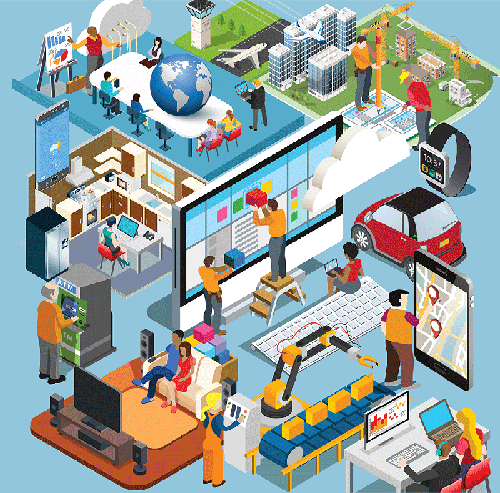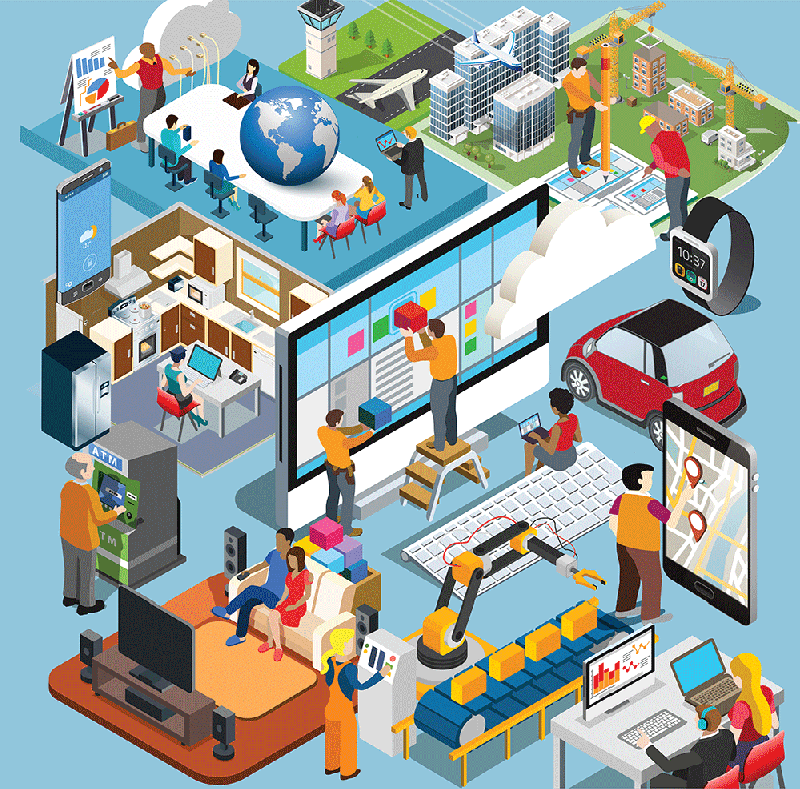Meetings: Building an Internet of Things
A version of this story ran in the May 2017 issue of APS News.
Some weird stuff is online these days. From a swallowed pill, to a sheet beneath a rustling baby, to a New England tomato, each can now transmit data about its surroundings to the cloud.
Welcome to the brave new world of the Internet of Things (IoT) in which networks of sensors relay information about the physical world to “smart” machines that analyze and interpret the data. The IoT could revolutionize the way factories are run, how health care is delivered, and the future of transportation.
This potential—and the scientific advances that are needed to make it a reality—were presented in April at the Actualization of the Internet of Things conference in Monterey, California. The first such meeting to be organized by the APS Forum on Industrial & Applied Physics brought together roughly 60 engineers, entrepreneurs, and scientists.
A meeting like this is timely. By 2020, it is estimated that more than 20 billion devices will be connected to the internet. And within a decade, the economic impact of the IoT could reach $11 trillion per year.
Part of what’s driving the IoT is the proliferation of high-quality detectors, such as cameras and chemical sensors. These can be distributed in cities and power plants, on land or in the sky, acting as high-resolution “eyes” and “noses” that surpass human capabilities. “The physical world is being digitized,” said Heike Riel, the director of physical sciences research at IBM in Zurich.
Riel gave the example of “precision agriculture,” in which farmers rely on satellite data to control which parts of a field receive water—as opposed to watering the whole field at once. Using this approach, IBM helped the California winemaker Gallo reduce water consumption in a test vineyard by 25%.
While many IoT applications could use existing sensors, others will require more specialized technology. David Chow, who oversees microelectronics at HRL Laboratories in Malibu, described radio frequency circuits made from graphene embedded in a sheet of microbial cellulose, a biocompatible and flexible material produced by bacteria. Such circuits are elastic enough to be integrated with tissue in the body and might one day be used to stimulate a prosthetic limb via remote control.
But sensors alone aren’t enough: You need a “brain” to process and interpret the colossal amounts of data that the IoT generates, and a number of presentations at the meeting highlighted advances in artificial intelligence and machine learning that are making this possible.
This is where quantum computing might eventually play a role, suggested physicist Seth Lloyd of MIT. “Many of the things we’re doing with classical machine learning could get an exponential speed-up with a quantum computer,” he said. That’s because quantum computers are whizzes at linear algebra, the mathematics used in search and optimization algorithms.
Of course something has to power all of this sensing and processing, which is creating a demand for new types of batteries. Andy Keates, an engineer at Intel in Santa Clara, explained that while there are many battery options, it may be difficult to find one that is both compact and satisfies the many requirements for IoT devices. “Honestly, no one is ever fully satisfied with their batteries,” he said.
Speakers at the meeting didn’t shy away from voicing the potential downsides of the IoT. A big concern is security. Last October, for example, hackers harnessed video cameras and other unprotected devices on the internet to orchestrate a denial-of-service attack that took down major sites such as Netflix and Twitter.
Nancy Cam-Winget, an engineer at Cisco specializing in IoT security, presented this vulnerability issue as a challenge to physicists, who will need to design devices for the IoT with enough room for self-protection hardware, but at a cost that companies are willing to swallow.
There’s also the natural aversion to having machines take over our lives. Self-driving cars sound great—until you’re in one and it makes a mistake. “We don’t have a high tolerance [for accidents] when machines are involved,” said Allen Adler, who leads technology strategy for Boeing.
And if you find this hooked-up world of spying objects disturbing, you aren’t alone. Jeffrey Hunt, a physicist at Boeing in Los Angeles who chairs FIAP and co-organized the meeting, says that when he first heard about the IoT, “I went home ready to cut my cables and wear a tin hat.” Lloyd confessed that he also finds the idea of being watched by so many devices “creepy.”
Barbara Jones, a physicist at IBM in Almaden and former FIAP chair who organized the meeting with Hunt, advocated for educating the public to prevent unnecessary fear. The IoT should be an “easy sell,” she said, both because it’s useful to industry and because it sounds cool. She said the challenge will come if sensors aren’t just used for obvious benefits and are increasingly found “in cities, in suburbs, in schools.”
And while Hunt says he’ll continue to cover the camera on his laptop, he also believes the IoT is an opportunity that shouldn’t be missed.
–Jessica Thomas





